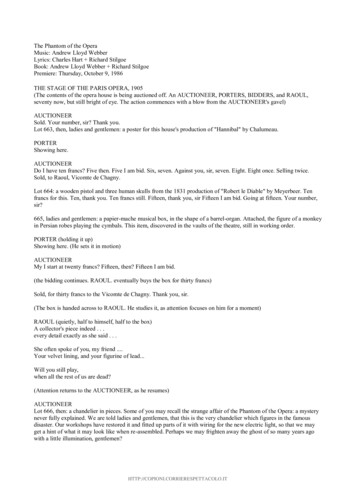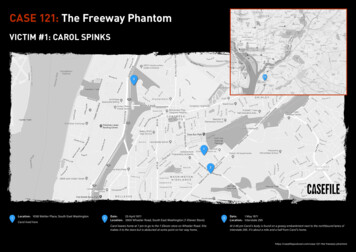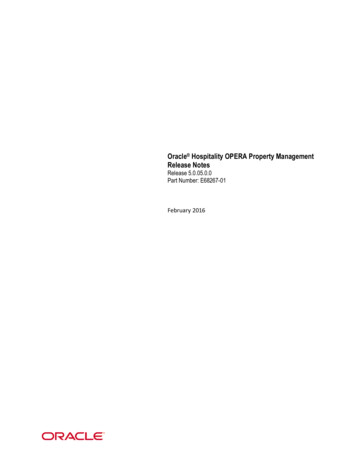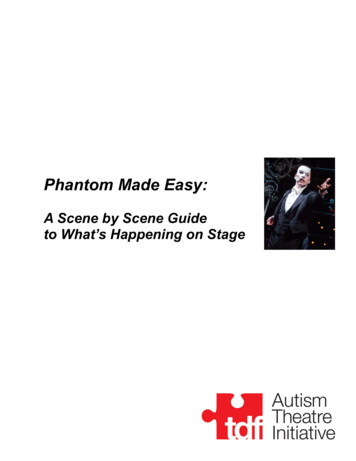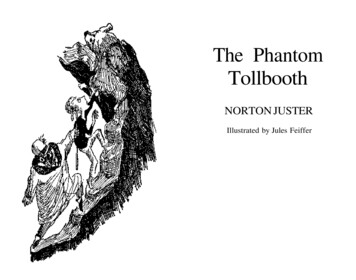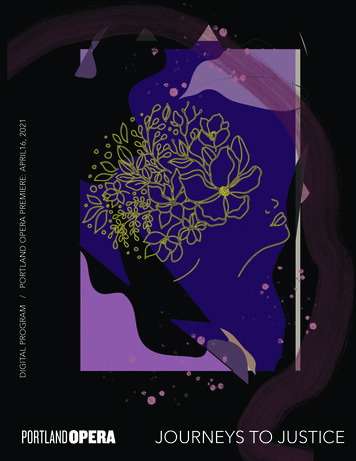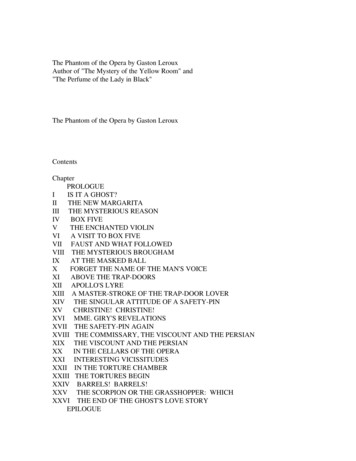
Transcription
The Phantom of the Opera by Gaston LerouxAuthor of "The Mystery of the Yellow Room" and"The Perfume of the Lady in Black"The Phantom of the Opera by Gaston LerouxContentsChapterPROLOGUEIIS IT A GHOST?IITHE NEW MARGARITAIII THE MYSTERIOUS REASONIVBOX FIVEVTHE ENCHANTED VIOLINVIA VISIT TO BOX FIVEVII FAUST AND WHAT FOLLOWEDVIII THE MYSTERIOUS BROUGHAMIXAT THE MASKED BALLXFORGET THE NAME OF THE MAN'S VOICEXIABOVE THE TRAP-DOORSXII APOLLO'S LYREXIII A MASTER-STROKE OF THE TRAP-DOOR LOVERXIV THE SINGULAR ATTITUDE OF A SAFETY-PINXVCHRISTINE! CHRISTINE!XVI MME. GIRY'S REVELATIONSXVII THE SAFETY-PIN AGAINXVIII THE COMMISSARY, THE VISCOUNT AND THE PERSIANXIX THE VISCOUNT AND THE PERSIANXXIN THE CELLARS OF THE OPERAXXI INTERESTING VICISSITUDESXXII IN THE TORTURE CHAMBERXXIII THE TORTURES BEGINXXIV BARRELS! BARRELS!XXV THE SCORPION OR THE GRASSHOPPER: WHICHXXVI THE END OF THE GHOST'S LOVE STORYEPILOGUE
{plus a "bonus chapter" called "THE PARIS OPERA HOUSE"}The Phantom of the OperaPrologueIN WHICH THE AUTHOR OF THIS SINGULAR WORK INFORMS THE READERHOWHE ACQUIRED THE CERTAINTY THAT THE OPERA GHOST REALLY EXISTEDThe Opera ghost really existed. He was not, as was long believed,a creature of the imagination of the artists, the superstition ofthe managers, or a product of the absurd and impressionable brainsof the young ladies of the ballet, their mothers, the box-keepers,the cloak-room attendants or the concierge. Yes, he existedin flesh and blood, although he assumed the complete appearanceof a real phantom; that is to say, of a spectral shade.When I began to ransack the archives of the National Academy ofMusic I was at once struck by the surprising coincidences betweenthe phenomena ascribed to the "ghost" and the most extraordinaryand fantastic tragedy that ever excited the Paris upper classes;and I soon conceived the idea that this tragedy might reasonablybe explained by the phenomena in question. The events do notdate more than thirty years back; and it would not be difficultto find at the present day, in the foyer of the ballet, old menof the highest respectability, men upon whose word one couldabsolutely rely, who would remember as though they happened yesterdaythe mysterious and dramatic conditions that attended the kidnappingof Christine Daae, the disappearance of the Vicomte de Chagnyand the death of his elder brother, Count Philippe, whose bodywas found on the bank of the lake that exists in the lower cellarsof the Opera on the Rue-Scribe side. But none of those witnesseshad until that day thought that there was any reason for connectingthe more or less legendary figure of the Opera ghost with that terrible story.
The truth was slow to enter my mind, puzzled by an inquiry thatat every moment was complicated by events which, at first sight,might be looked upon as superhuman; and more than once I waswithin an ace of abandoning a task in which I was exhaustingmyself in the hopeless pursuit of a vain image. At last,I received the proof that my presentiments had not deceived me,and I was rewarded for all my efforts on the day when I acquiredthe certainty that the Opera ghost was more than a mere shade.On that day, I had spent long hours over THE MEMOIRS OF A MANAGER,the light and frivolous work of the too-skeptical Moncharmin, who,during his term at the Opera, understood nothing of the mysteriousbehavior of the ghost and who was making all the fun of it that hecould at the very moment when he became the first victim of thecurious financial operation that went on inside the "magic envelope."I had just left the library in despair, when I met the delightfulacting-manager of our National Academy, who stood chatting on a landingwith a lively and well-groomed little old man, to whom he introducedme gaily. The acting-manager knew all about my investigationsand how eagerly and unsuccessfully I had been trying to discoverthe whereabouts of the examining magistrate in the famous Chagny case,M. Faure. Nobody knew what had become of him, alive or dead;and here he was back from Canada, where he had spent fifteen years,and the first thing he had done, on his return to Paris, was to cometo the secretarial offices at the Opera and ask for a free seat.The little old man was M. Faure himself.We spent a good part of the evening together and he told me the wholeChagny case as he had understood it at the time. He was bound toconclude in favor of the madness of the viscount and the accidentaldeath of the elder brother, for lack of evidence to the contrary;but he was nevertheless persuaded that a terrible tragedy had takenplace between the two brothers in connection with Christine Daae.He could not tell me what became of Christine or the viscount.When I mentioned the ghost, he only laughed. He, too, had been toldof the curious manifestations that seemed to point to the existenceof an abnormal being, residing in one of the most mysteriouscorners of the Opera, and he knew the story of the envelope;but he had never seen anything in it worthy of his attentionas magistrate in charge of the Chagny case, and it was as muchas he had done to listen to the evidence of a witness who appearedof his own accord and declared that he had often met the ghost.This witness was none other than the man whom all Paris called the"Persian" and who was well-known to every subscriber to the Opera.
The magistrate took him for a visionary.I was immensely interested by this story of the Persian. I wanted,if there were still time, to find this valuable and eccentric witness.My luck began to improve and I discovered him in his little flatin the Rue de Rivoli, where he had lived ever since and where he diedfive months after my visit. I was at first inclined to be suspicious;but when the Persian had told me, with child-like candor,all that he knew about the ghost and had handed me the proofsof the ghost's existence--including the strange correspondenceof Christine Daae--to do as I pleased with, I was no longer ableto doubt. No, the ghost was not a myth!I have, I know, been told that this correspondence may have beenforged from first to last by a man whose imagination had certainlybeen fed on the most seductive tales; but fortunately I discoveredsome of Christine's writing outside the famous bundle of letters and,on a comparison between the two, all my doubts were removed.I also went into the past history of the Persian and found that hewas an upright man, incapable of inventing a story that might havedefeated the ends of justice.This, moreover, was the opinion of the more serious people who,at one time or other, were mixed up in the Chagny case, who werefriends of the Chagny family, to whom I showed all my documentsand set forth all my inferences. In this connection, I shouldlike to print a few lines which I received from General D------:SIR:I can not urge you too strongly to publish the results of your inquiry.I remember perfectly that, a few weeks before the disappearanceof that great singer, Christine Daae, and the tragedy whichthrew the whole of the Faubourg Saint-Germain into mourning,there was a great deal of talk, in the foyer of the ballet,on the subject of the "ghost;" and I believe that it only ceasedto be discussed in consequence of the later affair that excited usall so greatly. But, if it be possible--as, after hearing you,I believe--to explain the tragedy through the ghost, then Ibeg you sir, to talk to us about the ghost again.Mysterious though the ghost may at first appear, he will alwaysbe more easily explained than the dismal story in which malevolentpeople have tried to picture two brothers killing each otherwho had worshiped each other all their lives.
Believe me, etc.Lastly, with my bundle of papers in hand, I once more went overthe ghost's vast domain, the huge building which he had madehis kingdom. All that my eyes saw, all that my mind perceived,corroborated the Persian's documents precisely; and a wonderfuldiscovery crowned my labors in a very definite fashion. It will beremembered that, later, when digging in the substructure of the Opera,before burying the phonographic records of the artist's voice,the workmen laid bare a corpse. Well, I was at once ableto prove that this corpse was that of the Opera ghost. I madethe acting-manager put this proof to the test with his own hand;and it is now a matter of supreme indifference to me if the paperspretend that the body was that of a victim of the Commune.The wretches who were massacred, under the Commune, in the cellarsof the Opera, were not buried on this side; I will tell where theirskeletons can be found in a spot not very far from that immense cryptwhich was stocked during the siege with all sorts of provisions.I came upon this track just when I was looking for the remainsof the Opera ghost, which I should never have discovered but forthe unheard-of chance described above.But we will return to the corpse and what ought to be done with it.For the present, I must conclude this very necessary introductionby thanking M. Mifroid (who was the commissary of police called in forthe first investigations after the disappearance of Christine Daae),M. Remy, the late secretary, M. Mercier, the late acting-manager,M. Gabriel, the late chorus-master, and more particularly Mme. laBaronne de Castelot-Barbezac, who was once the "little Meg"of the story (and who is not ashamed of it), the most charming starof our admirable corps de ballet, the eldest daughter of the worthyMme. Giry, now deceased, who had charge of the ghost's private box.All these were of the greatest assistance to me; and, thanks to them,I shall be able to reproduce those hours of sheer love and terror,in their smallest details, before the reader's eyes.And I should be ungrateful indeed if I omitted, while standingon the threshold of this dreadful and veracious story, to thankthe present management the Opera, which has so kindly assisted mein all my inquiries, and M. Messager in particular, together withM. Gabion, the acting-manager, and that most amiable of men,the architect intrusted with the preservation of the building,who did not hesitate to lend me the works of Charles Garnier,
although he was almost sure that I would never return them to him.Lastly, I must pay a public tribute to the generosity of my friendand former collaborator, M. J. Le Croze, who allowed me to dipinto his splendid theatrical library and to borrow the raresteditions of books by which he set great store.GASTON LEROUX.Chapter I Is it the Ghost?It was the evening on which MM. Debienne and Poligny, the managers ofthe Opera, were giving a last gala performance to mark their retirement.Suddenly the dressing-room of La Sorelli, one of the principal dancers,was invaded by half-a-dozen young ladies of the ballet, who had comeup from the stage after "dancing" Polyeucte. They rushed in amidgreat confusion, some giving vent to forced and unnatural laughter,others to cries of terror. Sorelli, who wished to be alone for a momentto "run through" the speech which she was to make to the resigningmanagers, looked around angrily at the mad and tumultuous crowd.It was little Jammes--the girl with the tip-tilted nose,the forget-me-not eyes, the rose-red cheeks and the lily-whiteneck and shoulders--who gave the explanation in a trembling voice:"It's the ghost!" And she locked the door.Sorelli's dressing-room was fitted up with official, commonplace elegance.A pier-glass, a sofa, a dressing-table and a cupboard or two providedthe necessary furniture. On the walls hung a few engravings,relics of the mother, who had known the glories of the old Opera inthe Rue le Peletier; portraits of Vestris, Gardel, Dupont, Bigottini.But the room seemed a palace to the brats of the corps de ballet,who were lodged in common dressing-rooms where they spent theirtime singing, quarreling, smacking the dressers and hair-dressersand buying one another glasses of cassis, beer, or even rhum,until the call-boy's bell rang.Sorelli was very superstitious. She shuddered when she heardlittle Jammes speak of the ghost, called her a "silly little fool"and then, as she was the first to believe in ghosts in general,and the Opera ghost in particular, at once asked for details:"Have you seen him?"
"As plainly as I see you now!" said little Jammes, whose legs weregiving way beneath her, and she dropped with a moan into a chair.Thereupon little Giry--the girl with eyes black as sloes,hair black as ink, a swarthy complexion and a poor little skinstretched over poor little bones--little Giry added:"If that's the ghost, he's very ugly!""Oh, yes!" cried the chorus of ballet-girls.And they all began to talk together. The ghost had appeared to themin the shape of a gentleman in dress-clothes, who had suddenly stoodbefore them in the passage, without their knowing where he came from.He seemed to have come straight through the wall."Pooh!" said one of them, who had more or less kept her head."You see the ghost everywhere!"And it was true. For several months, there had been nothing discussedat the Opera but this ghost in dress-clothes who stalked aboutthe building, from top to bottom, like a shadow, who spoke to nobody,to whom nobody dared speak and who vanished as soon as he was seen,no one knowing how or where. As became a real ghost, he made no noisein walking. People began by laughing and making fun of this specterdressed like a man of fashion or an undertaker; but the ghost legendsoon swelled to enormous proportions among the corps de ballet.All the girls pretended to have met this supernatural being moreor less often. And those who laughed the loudest were not the mostat ease. When he did not show himself, he betrayed his presenceor his passing by accident, comic or serious, for which the generalsuperstition held him responsible. Had any one met with a fall,or suffered a practical joke at the hands of one of the other girls,or lost a powderpuff, it was at once the fault of the ghost,of the Opera ghost.After all, who had seen him?
{plus a "bonus chapter" called "THE PARIS OPERA HOUSE"} The Phantom of the Opera Prologue IN WHICH THE AUTHOR OF THIS SINGULAR WORK INFORMS THE READER HOW HE ACQUIRED THE CERTAINTY THAT THE OPERA GHOST REALLY EXISTED The Opera ghost really existed. He was not, as was long believed, a creature of the imagination of the artists, the superstition ofFile Size: 814KBPage Count: 236Explore furtherThe Phantom of the Opera By Gaston Leroux - (PDF/READ)www.pdfread.netThe phantom of the opera : Leroux, Gaston, 1868-1927 .archive.org(PDF) THE PHANTOM OF THE OPERA Rachel Hiddlestoner .www.academia.eduThe Phantom of the Opera by Gaston Leroux Plot Summary .www.litcharts.comThe Phantom of the Opera Summary GradeSaverwww.gradesaver.comRecommended to you based on what's popular Feedback

